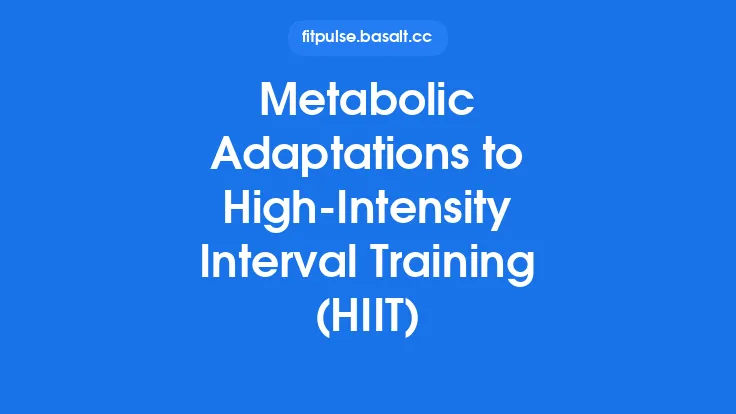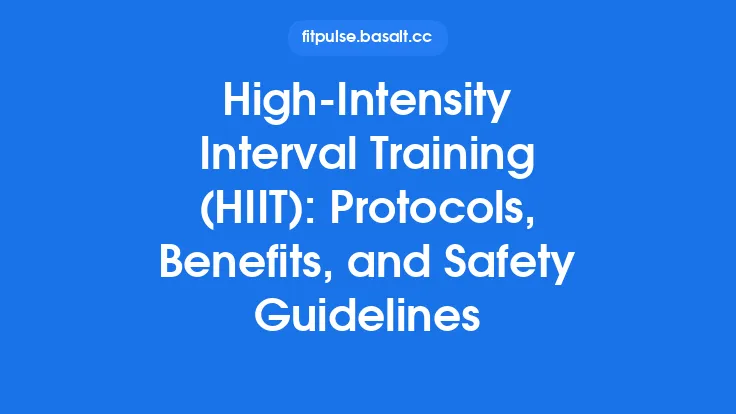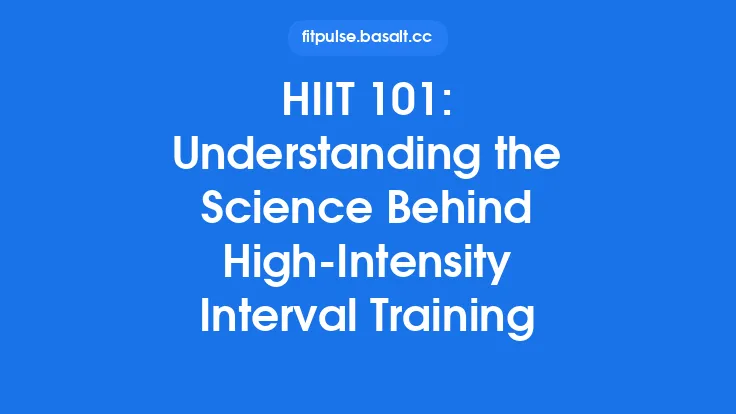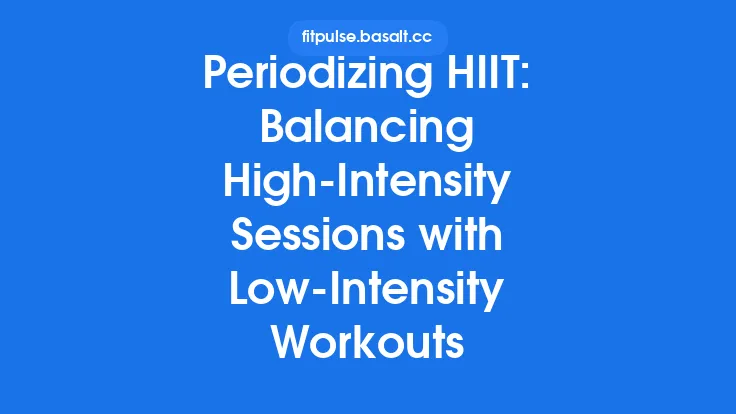High‑Intensity Interval Training (HIIT) has become a cornerstone of modern fitness because it delivers substantial cardiovascular and metabolic benefits in a fraction of the time required by traditional steady‑state cardio. When you strip away the need for treadmills, stationary bikes, or rowing machines, the challenge shifts from “what equipment can I use?” to “how can I structure the intervals, intensity, and progression to maximize results?” This guide walks you through the science‑backed framework for building HIIT sessions that rely solely on bodyweight movements, space, and timing—no machines required.
Fundamentals of HIIT Physiology
Understanding the physiological underpinnings of HIIT is essential for purposeful programming. HIIT primarily taxes two energy systems:
- Phosphagen (ATP‑PCr) System – Fuels maximal effort bursts lasting 0–10 seconds. It provides immediate energy for explosive actions such as sprinting in place or rapid burpees.
- Anaerobic Glycolysis – Dominates efforts lasting roughly 10–60 seconds, generating ATP through the breakdown of glucose without oxygen. This pathway produces lactate, which is a key driver of the “afterburn” effect (excess post‑exercise oxygen consumption, EPOC).
When work intervals exceed the phosphagen capacity, the body transitions to glycolysis, accumulating metabolites that stimulate hormonal responses (e.g., catecholamines, growth hormone) and elevate post‑exercise metabolic rate. The brief recovery periods allow partial phosphagen replenishment while maintaining elevated heart rate, ensuring the cardiovascular system remains challenged.
Key takeaway: The length of the work interval determines which energy system is emphasized. Short, maximal bursts target power; longer intervals shift the stimulus toward glycolytic conditioning and metabolic stress.
Designing the Work‑to‑Rest Ratio
The work‑to‑rest ratio (W:R) is the most influential variable in a HIIT session. It dictates intensity, recovery, and the overall training stimulus.
| Goal | Typical Work Duration | Typical Rest Duration | Common W:R |
|---|---|---|---|
| Power & Speed | 5–10 s | 20–30 s | 1:4 – 1:6 |
| Aerobic Conditioning | 30–45 s | 60–90 s | 1:2 – 1:3 |
| Fat‑Loss / EPOC | 20–40 s | 10–20 s | 1:0.5 – 1:1 |
| Mixed Metabolic | 15–30 s | 30–45 s | 1:1 – 1:2 |
Why the ratio matters:
- Shorter rest (lower ratio) forces the cardiovascular system to stay near maximal heart rate, amplifying EPOC.
- Longer rest (higher ratio) allows near‑full phosphagen recovery, enabling higher power output on each work bout.
When programming without machines, you can fine‑tune the ratio by adjusting the timer rather than relying on external load. Start with a conservative ratio (e.g., 1:2) and modify based on the athlete’s perceived exertion and heart‑rate response.
Choosing Appropriate Bodyweight Movements
The movement selection should align with the chosen W:R and the desired training outcome. Because the focus is on interval structure rather than skill progression, prioritize exercises that:
- Recruit large muscle groups – Squats, lunges, push‑ups, and mountain climbers engage multiple joints, raising oxygen demand.
- Allow rapid turnover – Movements that can be performed continuously without excessive technique breakdown (e.g., high knees, jumping jacks).
- Offer scalable intensity – Simple modifications (e.g., adding a hop, increasing range of motion) let you adjust effort without changing the exercise itself.
Avoid overly technical calisthenics (e.g., handstand push‑ups) or pure plyometric drills that would shift the session into a skill‑oriented or agility‑focused domain, which belongs to neighboring article scopes. Instead, keep the repertoire functional and repeatable.
Examples of suitable movements:
| Category | Movement | Why It Fits HIIT |
|---|---|---|
| Lower‑body | Jump squats, alternating forward lunges, squat‑to‑high‑kick | Generates high vertical force, quick turnover |
| Upper‑body | Plyometric push‑ups (hands off the ground), alternating shoulder taps, plank jacks | Engages chest, shoulders, core while allowing rapid pacing |
| Full‑body | Burpees (without the jump), bear crawls, squat‑to‑press (bodyweight) | Simultaneous cardio and strength stimulus |
| Core/Dynamic | Mountain climbers, high‑knees, plank‑to‑down‑dog | Keeps heart rate elevated, minimal equipment |
Structuring the Session Timeline
A well‑balanced HIIT session comprises three phases: Preparation, Main Set, and Recovery. Below is a modular template that can be adapted to any W:R and total session length.
- Preparation (5–10 minutes)
- Dynamic warm‑up: Leg swings, arm circles, hip openers, and light cardio (e.g., marching in place).
- Activation drills: Glute bridges, scapular push‑ups, or band‑free shoulder rotations to prime the neuromuscular system.
- Main Set (12–25 minutes)
- Block 1 – Power Emphasis (optional): 4–6 rounds of 5‑second maximal effort (e.g., jump squats) with 25‑second rest (1:5 ratio).
- Block 2 – Metabolic Conditioning: 8–12 rounds of 30‑second work (chosen movement) with 30‑second rest (1:1 ratio).
- Block 3 – Finisher (optional): 2–4 rounds of 20‑second all‑out effort with 10‑second rest (1:0.5 ratio) to maximize EPOC.
Note: The total number of rounds can be adjusted to fit the desired session duration. For beginners, start with fewer rounds and gradually increase as conditioning improves.
- Recovery (5–10 minutes)
- Active cool‑down: Low‑intensity movement (e.g., slow walking, gentle marching) to gradually lower heart rate.
- Static stretching: Target major muscle groups used during the session, holding each stretch for 20–30 seconds.
Timing tools: A simple smartphone timer, interval apps, or a basic stopwatch are sufficient. Consistency in timing is crucial for reproducibility and progressive overload.
Progression Strategies Over Time
Progression in HIIT is not about adding weight but about systematically increasing the stimulus while preserving technique and safety. Consider the following levers:
| Progression Lever | How to Apply |
|---|---|
| Increase Work Duration | Add 5‑second increments to each work interval (e.g., 30 s → 35 s) while keeping rest constant. |
| Decrease Rest Duration | Reduce rest by 5‑second increments (e.g., 30 s → 25 s) to raise the intensity ratio. |
| Add Rounds | Extend the total number of intervals (e.g., from 8 to 10 rounds) to increase volume. |
| Complexify Movements | Introduce a small, controlled variation (e.g., from squat to squat‑to‑alternating‑kick) that raises muscular demand without requiring equipment. |
| Manipulate Tempo | Shorten the eccentric (lowering) phase of a movement to increase speed and power output. |
| Incorporate Dual‑Task Elements | Combine two simple movements (e.g., squat + high‑knee) to raise coordination demand and heart‑rate response. |
A practical progression model might follow a micro‑cycle of three weeks:
- Week 1: Baseline (e.g., 30 s work / 30 s rest, 8 rounds).
- Week 2: Add 2 rounds (total 10).
- Week 3: Reduce rest to 25 s while maintaining work duration (30 s / 25 s, 10 rounds).
After the three‑week block, reassess perceived exertion and heart‑rate data, then reset or continue the progression based on the athlete’s adaptation.
Monitoring Intensity and Recovery
Because HIIT relies heavily on cardiovascular stress, objective monitoring helps ensure the session stays within the intended intensity zone.
- Heart‑Rate Zones
- Target Zone for HIIT: 85–95 % of maximum heart rate (HRmax).
- Estimating HRmax: 220 – age (or use the Tanaka formula: 208 – 0.7 × age for a slightly more accurate estimate).
- Practical tip: Use a chest‑strap or optical heart‑rate monitor; if unavailable, the “talk test” (you should be unable to speak more than a few words during work intervals) is a reasonable proxy.
- Rate of Perceived Exertion (RPE)
- Scale of 1–10, where 8–9 corresponds to “hard” to “very hard.”
- Record RPE after each block; a consistent rise indicates insufficient recovery or excessive load.
- Recovery Heart‑Rate Drop
- Measure heart rate at the end of a work interval and again after the rest period. A drop of ≥ 20 bpm suggests adequate recovery; smaller drops may signal the need for longer rest.
- Lactate & Breathlessness
- While lab testing isn’t practical, athletes can gauge breathlessness. If they cannot complete the prescribed work due to early fatigue, the work duration may be too long for their current conditioning.
Data‑driven adjustments: If heart‑rate data shows the athlete is consistently below the target zone, consider shortening rest or extending work. Conversely, if heart rate spikes excessively (e.g., > 95 % HRmax) and RPE is 10, increase rest or reduce work duration.
Integrating HIIT into a Weekly Training Plan
HIIT is a potent stimulus, but it also imposes significant neuromuscular and metabolic stress. Proper placement within a weekly schedule maximizes benefits while minimizing overtraining.
| Training Frequency | Recommended Sessions | Sample Weekly Layout |
|---|---|---|
| Beginner | 2 HIIT sessions/week | Mon – HIIT (Metabolic), Thu – HIIT (Power) |
| Intermediate | 3 HIIT sessions/week | Mon – HIIT (Metabolic), Wed – HIIT (Power), Fri – HIIT (Finisher) |
| Advanced | 4–5 HIIT sessions/week (with varied emphasis) | Mon – Power Block, Tue – Metabolic Block, Thu – Power Block, Fri – Finisher + Light cardio |
Key considerations:
- Spacing: Allow at least 48 hours between high‑intensity blocks that heavily tax the same muscle groups.
- Complementary Work: Pair HIIT days with low‑intensity mobility or steady‑state cardio on off days to promote recovery.
- Periodization: Cycle through phases of higher volume (more rounds) and higher intensity (shorter rest) every 4–6 weeks to avoid plateaus.
Safety, Warm‑up, and Cool‑down Protocols
Even without equipment, HIIT can be demanding on joints and the cardiovascular system. Implement these safeguards:
- Pre‑session Screening
- Verify that participants have medical clearance for high‑intensity work, especially if they have cardiovascular risk factors.
- Conduct a brief movement competency check (e.g., squat depth, hip hinge) to ensure safe execution.
- Dynamic Warm‑up (5–10 min)
- Joint mobility: Ankle circles, wrist rolls, thoracic rotations.
- Movement prep: Bodyweight squat to stand, inchworm walk‑outs, high‑knee march.
- Gradual cardio ramp: 30 seconds of light jogging in place, progressing to 30 seconds of faster marching.
- Technique Emphasis
- Prioritize proper landing mechanics (soft knees, mid‑foot strike) during jumps.
- Keep the core engaged to protect the lumbar spine during push‑up variations.
- Cool‑down (5–10 min)
- Active recovery: Slow walking or gentle marching to bring heart rate down gradually.
- Static stretching: Hold each stretch for 20–30 seconds, focusing on hip flexors, quadriceps, chest, and shoulders.
- Post‑session Recovery
- Encourage hydration, adequate protein intake, and sleep.
- For athletes experiencing excessive soreness, incorporate a light mobility session or a low‑intensity walk the following day.
Common Pitfalls and How to Avoid Them
| Pitfall | Why It Happens | Solution |
|---|---|---|
| Over‑reliance on “all‑out” effort every round | Desire for maximal calorie burn leads to premature fatigue. | Use a graded intensity approach: start the first half of the set at 80 % effort, then increase to 90‑95 % for the final rounds. |
| Inconsistent timing | Manual timers can drift, causing work or rest periods to be longer/shorter than intended. | Use a dedicated interval app or a programmable timer that beeps for each transition. |
| Neglecting warm‑up | Rushing into high intensity raises injury risk. | Treat the warm‑up as a non‑negotiable part of the session; schedule it as a separate block. |
| Choosing overly complex movements | Trying to make the session “fancy” leads to poor form and reduced intensity. | Stick to simple, repeatable movements that can be performed with consistent technique throughout the set. |
| Failing to track progress | Without data, it’s hard to know if the stimulus is sufficient. | Log work/rest durations, RPE, and heart‑rate averages after each session; review weekly. |
| Doing HIIT on consecutive days | Insufficient recovery can cause cumulative fatigue and performance decline. | Space HIIT sessions at least 48 hours apart or alternate intensity focus (e.g., power vs. metabolic). |
Sample Session Templates
Below are three ready‑to‑use HIIT session outlines. Adjust the work‑to‑rest ratios, number of rounds, or movement selections to suit the athlete’s fitness level and goals.
1. Metabolic Conditioning – “The 30/30 Classic”
- Warm‑up: 5 min dynamic mobility (leg swings, arm circles, light jog).
- Main Set: 8 rounds of
- 30 s Alternating Forward Lunges (quick, controlled)
- 30 s Rest (active: marching in place)
- Cool‑down: 5 min low‑intensity walk + static stretch.
Progression: Add 2 rounds each week or reduce rest to 20 s after week 2.
2. Power Block – “Explosive Sprint Circuit”
- Warm‑up: 5 min joint prep + 2 × 20 s high‑knee march (gradually increasing speed).
- Main Set: 6 rounds of
- 5 s Jump Squats (max height)
- 25 s Rest (stand, deep breaths)
- Cool‑down: 5 min gentle walking + hip flexor stretch.
Progression: Increase work to 7 s while keeping rest at 25 s, or add a second movement (e.g., 5 s push‑up plyos) for a dual‑modal power block.
3. Finisher – “EPOC Blast”
- Warm‑up: 5 min dynamic flow (inch‑worm to plank, shoulder taps).
- Main Set: 4 rounds of
- 20 s Burpee‑to‑High‑Knee (burpee without jump, finish with 2 high‑knees)
- 10 s Rest (stand, shake out limbs)
- Cool‑down: 5 min slow marching + full‑body stretch.
Progression: Increase rounds to 6 or extend work to 25 s while keeping rest at 10 s.
Final Thoughts
Designing HIIT sessions without machines is less about the tools you lack and more about the structure you impose. By mastering the interplay of work‑to‑rest ratios, movement selection, progressive overload, and objective monitoring, you can deliver a potent, equipment‑agnostic stimulus that improves cardiovascular fitness, metabolic health, and overall athletic capacity.
Remember that consistency, data‑driven adjustments, and proper recovery are the pillars that turn a series of short, intense bursts into lasting performance gains. Use the frameworks and templates above as a launchpad, then tailor each session to the unique needs and goals of the individual—or yourself—while staying rooted in the timeless principles of HIIT science.





